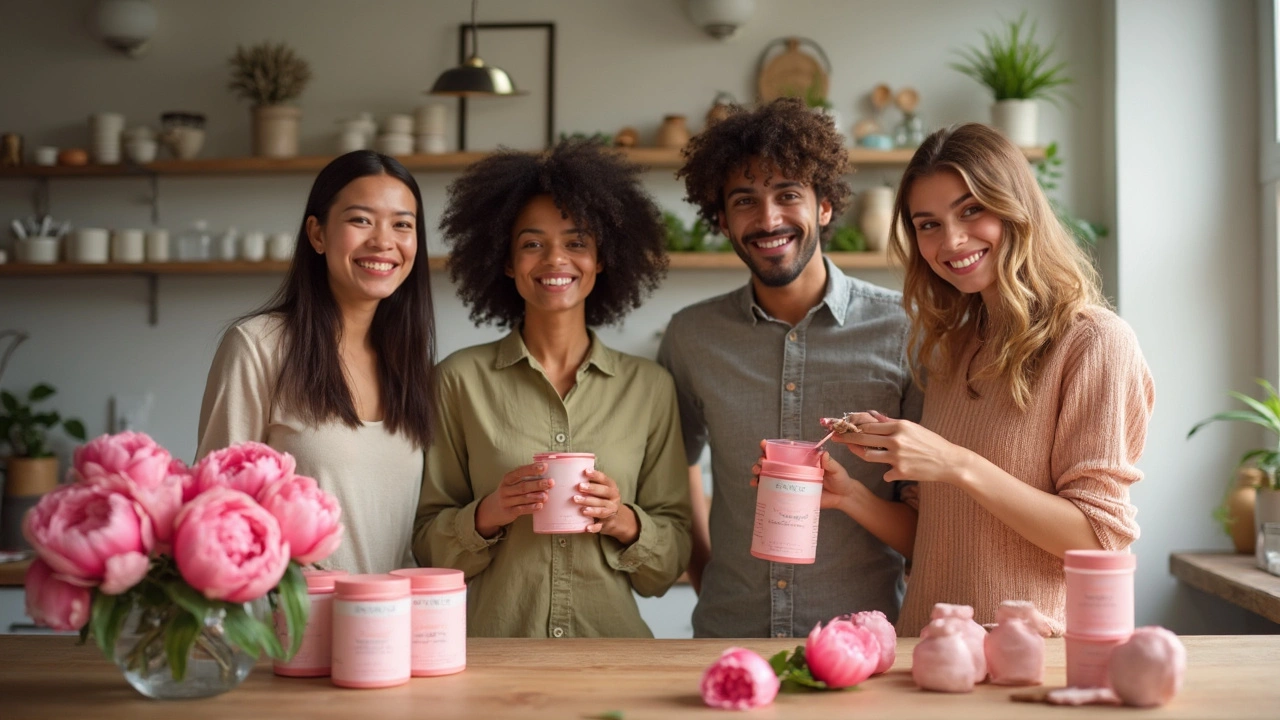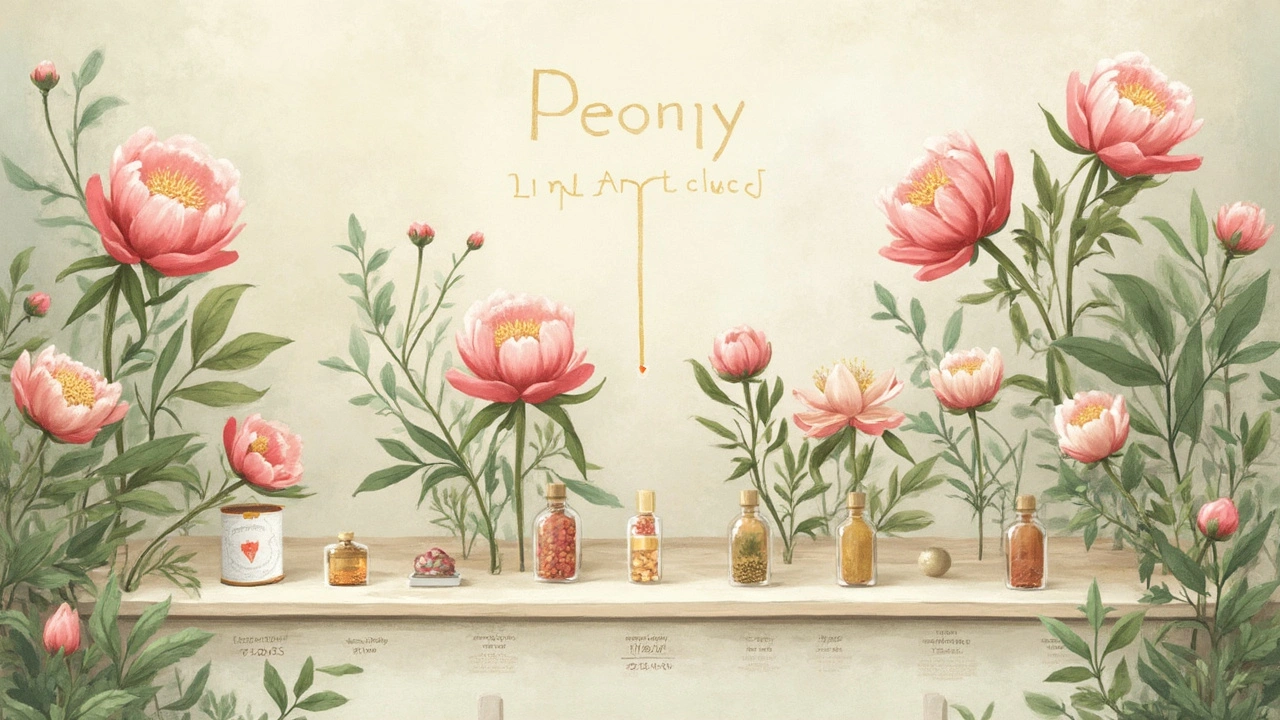Walk into any classic Chinese medicine shop and you’ll spot peony root stacked in careful bundles, a legend in herbal circles and often overlooked in the West. You might think of peonies as show-stopping garden blooms, the star of spring bouquets. But people have been grinding up their roots and petals for much deeper reasons—think pain relief, mental clarity, and soothing stubborn inflammation. With peony now slipping quietly into capsules and drinkable supplements, it’s time to dig up the science and see if this timeworn remedy can truly hold its own in the crowded world of modern self-care.
The Roots of Tradition: Peony’s Ancient Medical Legacy
When healers in ancient China reached for a remedy, peony root—called "bai shao" (white peony) or "chi shao" (red peony)—was usually close at hand. That’s not an exaggeration: written records on peony root stretch back at least 2,000 years. Peony was treasured in the Chinese pharmacopoeia for treating headaches and period pain, mellowing out the body's angry responses (inflammation), and even quieting frazzled nerves. In the famous medical text Shennong Ben Cao Jing, peony was called "sweet and slightly cold," ideal for balancing excess energy according to traditional theory. Want to know how important peony was? Ming Dynasty royalty used it for everything from skin eruptions to anemia, and Japanese Kampo medicine often relied on powders from the same root. Peony supplement isn't some recent wellness trend—it traces a direct line from these ancient cabinets right to today’s dietary supplement aisles.
There’s a reason peony held its spot while other ancient herbs faded away. Besides pain relief, healers believed peony could nourish the blood, keep the liver happy, and maintain healthy menstrual cycles for women. And here’s a quirky bit: they sometimes combined peony with licorice root to boost peony’s effects and reduce harshness, a practice still seen in modern supplement formulas. In fact, in places like Taiwan today, you’ll see peony extracts prescribed alongside prescription medicine, a strange but fascinating blend of old and new. Is there anything else with such crossover appeal? Rarely. But as more people turn to herbs in hopes of fewer side effects, peony’s appeal is only getting stronger.
From Field to Capsule: How Peony is Made and Used Today
Let’s get real: not all peony supplements are created equal. The best products start with the right species. Paeonia lactiflora gets most of the attention for dietary use, while Paeonia suffruticosa (tree peony) has its loyal fans too. Farmers pick roots from mature plants—usually between 3 and 5 years old—because younger roots just don’t pack the same punch. What happens next? These roots get cleaned, sliced, and sometimes boiled to soften the tough skin before being dried out. This process preserves the good stuff—compounds like paeoniflorin, albiflorin, and oxypaeoniflorin—that drive peony’s effects. Some supplements feature full-spectrum root powder, while others use alcohol or water extracts that concentrate the active compounds for more consistent dosing.
How do you actually take peony? Capsules and tablets are the go-tos, especially handy if you want to avoid the bitterness of old-school herbal teas. There’s also liquid peony tinctures for folks chasing faster absorption. Some supplement makers go one step further and blend peony with synergistic herbs—like the classic peony and licorice combo—to target things like cramps or stress. Right now, you’ll see peony supplements labeled for everything from "liver support" to "emotional balance" and "joint comfort." The dosing varies, but most standardized extracts hover between 300 to 600 mg per day. Still, the variety of products and labels means doing your homework is key. The best bet is products with third-party verification or a full list of active ingredients.

What’s Inside Peony? The Science of Peony’s Active Ingredients
The secret sauce here is paeoniflorin—a compound unique to peony—and a cocktail of other bioactive molecules found mostly in the root. Paeoniflorin has gotten a ton of lab attention for its potential anti-inflammatory, antispasmodic (think cramp relief), antioxidant, and calming effects. Lab tests show it works a bit like a multi-tool, acting on immune pathways, calming overactive pain messages, and possibly reducing oxidative stress. Research published in 2022 out of Japan flagged paeoniflorin as a possible helper in stabilizing mood and taming anxiety. Meanwhile, albiflorin is getting interest for nerve protection and boosting neuroplasticity. Neither of these are your average plant chemicals—they both act on the brain and body in some surprising ways.
Peony root also contains flavonoids, tannins, and monoterpene glycosides. The antioxidant punch from these can help defend your cells from day-to-day wear-and-tear. But here’s a twist: early experiments hint at peony’s ability to regulate hormones, particularly the ones tied to menstrual cycles. In a 2021 clinical review, researchers in Taiwan reported peony root could help with monthly discomfort and even irregular cycles by gently nudging hormone levels back toward normal. This might explain why women’s health formulas often feature peony alongside chasteberry or dong quai.
Is peony just a passing fad? Considering it’s one of the most-studied herbs in multi-herb formulas, the data is hard to ignore. Reviews keep finding it helps with immune balance, possibly fending off the kind of chronic inflammation that can age you before your time. Though most studies have been small or animal-based, the real surprise is just how many different health concerns link back to ingredients in this humble root. Still, big, well-designed studies in people are only starting to happen, so the puzzle’s not complete yet.
Peony for Modern Life: Potential Benefits and How It Might Help You
Everyone wants an edge—better focus, less stress, or smoother joints. Peony’s reputation spans all three, and then some. So what does the research actually say about its benefits?
- Reducing Inflammation and Joint Pain: Several Korean studies highlight peony’s ability to quiet aching joints and reduce swelling. In one trial out of Seoul, patients with rheumatoid arthritis who took a peony-based supplement noticed less morning stiffness after 8 weeks. Animal models confirm paeoniflorin’s knack for blocking key inflammatory signals. No, it’s not an overnight cure, but it appears to gently dial down the "fire" that fans pain and swelling. Joint blends often mix peony with turmeric or boswellia for a 1-2 punch.
- Menstrual Relief: Paeoniflorin may help by relaxing smooth muscle and nudging hormone levels into balance, which lines up with its traditional use in women’s health. Trials in China and Japan found improved comfort in up to 60% of women dealing with cycle-related woes. Some gynecologists in Asia reach for peony extracts for stubborn PMS or scanty periods, rarely as a solo treatment but often in blends.
- Mood and Stress Support: Peony isn’t just about the body—it can have gentle calming effects too. In a 2022 pilot study, adults with mild anxiety reported measurably lower anxiety scores after 30 days of standardized peony root. The theory is that paeoniflorin may boost serotonin and help regulate stress circuits in the brain. As mental health becomes a bigger focus for supplements, peony is quietly finding its place as a natural mood lifter.
- Liver Support: Traditional medicine has always linked peony with liver health, and the science is catching up. A 2020 review found peony extract helped support healthy liver enzyme levels and reduce fat buildup in several animal models. While not a cure, its potential for gentle liver support is now being tested in human studies, especially for those prone to fatty liver or sluggish digestion.
Peony supplements aren’t just for one niche. People looking for non-habit-forming relief for many low-level, chronic complaints might find it a useful add-on. And because peony tends to play nice with other herbs, it’s a popular base for complex formulas tailored to specific needs. One tip: start low and slow—try a half dose, see how your system handles it, then ease up as needed. This isn’t the quick-fix approach, but for anyone tired of harsh synthetic options, peony’s gentle touch might be worth exploring.

Buying Peony Supplements—Smart Tips and What to Watch For
Shopping for herbal supplements can be a bit like wandering a maze: labels brag about purity or strength, but the real gold is finding a product with both quality and transparency. Here’s what I look for when sizing up peony supplements for myself or friends.
- Know your peony: Double-check for Paeonia lactiflora or Paeonia suffruticosa on the ingredient list—the most studied species. Avoid mystery blends that don’t name their source plant.
- Standardized extract: Look for standardized labels showing how much paeoniflorin is inside (about 10-20% is common). This signals better quality control and more predictable results.
- Purity testing: The best brands test for heavy metals, pesticides, and contaminants. Bonus points for third-party certifications from NSF, USP, or ConsumerLab.
- Avoid unnecessary fillers: Simple formulas usually work better. Steer clear of supplements loaded with artificial colors, binders, or flavorings.
- Check synergy: Peony often pairs with licorice, dong quai, or chasteberry—this is fine if you want blended effects. If you’re trying peony for a specific issue, like menstrual comfort or focus, single-ingredient products help you focus on what’s working.
- Consult your doctor: If you’re pregnant, nursing, or on blood thinners, always check with your doctor. Peony can interact with some meds due to its mild blood-thinning effect. This stuff is powerful, not just a harmless "plant powder."
Another tip: start your supplement trial when you can monitor any changes. Keep a small journal—energy, mood, joint comfort, or monthly cycles—so you can notice subtle shifts over a month or two. The best insights are always personal. If you notice any tummy trouble or skin rashes (very rare, but possible), scale back or stop. Your body will always tell you more than the label does.
So there you have it: the peony’s story spans from ancient apothecary jars to today’s digital wellness carts. With a rising demand for natural, science-backed solutions, this humble flower keeps landing in more supplement routines every month. Who knew such a stunning garden centerpiece could be just as bold inside a capsule?

amanda luize
Reading this deep‑dive on peony, I can’t help but notice a cascade of grammatical slip‑ups that betray a careless editorial hand; the title itself-"Peony Supplement Benefits: Ancient Uses and Modern Science Unveiled"-should be punctuated with a colon, not a hyphen, and the phrase "quietly into capsules" begs for a clearer verb tense. Moreover, the author seems to overlook a crucial caveat: the very same pharmaceutical conglomerates that fund the touted studies are also the ones pushing the narrative that natural herbs are a panacea, a classic bait‑and‑switch designed to quell public skepticism. The mention of Paeonia lactiflora versus Paeonia suffruticosa is accurate, yet the text fails to differentiate the distinct phytochemical profiles, which is a glaring omission that could mislead a naïve reader. And let’s not forget the subtle insinuation that “modern supplement aisles” are a bastion of purity; in reality, supply‑chain opacity is rife, with many products containing filler extracts sourced from undisclosed farms. I also detect an overreliance on anecdotal references-"Ming Dynasty royalty" and "Kampo"-which, while colorful, lack the rigorous citation needed for a scientific treatise. If we peer behind the glossy veneer, it becomes evident that a shadowy network of “wellness influencers” orchestrates the hype, funneling profits to a handful of manufacturers who manipulate data to validate their own products. The article’s claim that peony “helps with hormone regulation” is suddenly plausible when you consider that several of the cited studies were conducted by labs that receive direct funding from supplement brands, a conflict of interest that should be disclosed upfront. Finally, the in‑depth discussion of paeoniflorin’s anti‑inflammatory properties is commendable, yet the author neglects to mention that the bioavailability of this compound is notoriously low when taken orally, unless paired with specific delivery systems-details that would save readers from false expectations. In short, while the piece is rich in evocative language, it betrays a pattern of selective reporting, hidden agenda, and lax editorial standards that any diligent reader should scrutinize.
Chris Morgan
Whatever the hype peony is just another herb with no real edge.
Pallavi G
Hey folks! If you’re curious about peony, start with a low dose and keep a simple journal of how you feel-energy, mood, any joint quirks. This way you’ll see real trends, not just marketing hype. Remember, consistency beats excitement every time.
Stay motivated and give your body the time it needs to adapt!
Rafael Lopez
Great point, everyone, and, as always, it’s essential to check for third‑party testing, because, you know, purity matters, especially when you’re ingesting herbal extracts! Also, look for the amount of paeoniflorin-ideally 10‑20%-so you know you’re getting the active ingredient, not just filler, and don’t forget to read the label for potential allergens!
Craig Mascarenhas
i think the whole peony fad is a distraction from the real pharma agenda they want us to think it’s natural but its all a cover up. the label stuff is just a smokescreen, dont trust the big corp.
aarsha jayan
While it’s easy to get caught up in conspiratorial vibes, let’s keep the conversation supportive. If you decide to try peony, consider a brand that lists its source and has a clear third‑party certificate. Sharing experiences can help us all navigate the supplement landscape together.
Rita Joseph
For anyone looking at the over‑punctuated advice above, a quick tip: start with a 300 mg standardized extract and monitor any changes for at least two weeks. If you notice a gentle mood lift or less joint stiffness, you’re likely seeing the benefits of paeoniflorin. If not, adjust the dose or try a different brand.
abhi sharma
Sure, because nature always knows better than science.
mas aly
I’m glad you mentioned journaling, because tracking subtle shifts can be the difference between attributing a change to peony or just normal daily variance. Also, a gentle reminder: if you’re on blood thinners, discuss peony with your physician before starting.
Abhishek Vora
Permit me to clarify: the pharmacodynamics of paeoniflorin are not merely “interesting” but pivotal in modulating NF‑κB pathways, thereby attenuating cytokine cascades. In layman’s terms, this means a potential reduction in systemic inflammation, a claim substantiated by multiple rodent models. Yet, the errant omission of human bioavailability data in many articles betrays a superficial grasp of translational relevance. Thus, while I laud the enthusiasm for integrating traditional botanicals, I implore the community to demand rigorously designed, double‑blind, placebo‑controlled trials before proclaiming peony a panacea.
maurice screti
One cannot help but marvel at the intricate tapestry woven by centuries of Eastern herbal wisdom, a tapestry now beckoning the modern consumer with promises of tranquility, joint relief, and hormonal harmony. Yet, as we stand at this crossroads of tradition and technology, it behooves us to interrogate the provenance of each capsule-was the root harvested at the apex of its phytochemical potency, or merely plucked from a mass‑production field? Moreover, the specter of commercial inertia looms large; companies, eager to capitalize on nostalgia, may eschew stringent quality controls in favor of volume, thereby diluting the very essence that renders peony remarkable. Consequently, the discerning seeker must navigate a labyrinth of labels, certifications, and peer‑reviewed literature, all while maintaining a healthy skepticism toward hyperbolic marketing. In doing so, one may yet reap the subtle, cumulative benefits that only a meticulously sourced, standardized peony extract can bestow.
Abigail Adams
Honestly, the pretentious prose above masks a very simple truth: most of these claims are overblown, and the average consumer will see negligible effects. The market is saturated with hype, and unless you’re a true herbal aficionado, your money is better spent elsewhere.
Belle Koschier
Let’s try to find common ground here. If you’re approaching peony with realistic expectations-seeking modest support for inflammation or mood rather than a miracle cure-you’ll likely be satisfied with a reputable product and a patient, measured approach.
Allison Song
In the grand schema of health, every herb is a thread in the fabric of our wellbeing; pulling too hard on one strand may unravel the whole tapestry, yet ignoring it entirely forfeits potential harmony. Balance, therefore, is the philosopher’s key.
Joseph Bowman
Friend, while I appreciate the poetic musings, let’s not forget that large pharma quietly funds many of these “studies” to keep the narrative under control. Trust the grassroots research, not the glossy press releases.
Singh Bhinder
Anyone tried peony for menstrual cramps? I’m curious if the dosage recommendations differ for that specific use.
Kelly Diglio
Your curiosity is spot‑on. While most guidelines suggest 300‑600 mg of a standardized extract daily, many women report starting at the lower end and titrating up based on comfort. Keep a brief log of cramp intensity and any side effects; this will guide you toward the sweet spot.